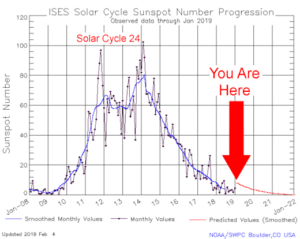in GWPF, March 11, 2019
London, 11 March: A new report from the Global Warming Policy Foundation reveals that the solar influence on climate is is much larger than is generally recognised.
The report, by Professor Henrik Svensmark of the Danish National Space Institute, outlines some of the remarkable correlations between solar activity and past climate changes. It also shows that the output of the Sun alone – the so-called total solar irradiance – cannot explain them.
“Changes in total solar irradiance are actually quite small”, says Professor Svensmark. “They would have to be nearly 10 times larger to explain how the oceans warm and cool over the 11-year solar cycle.”
New research suggests that other mechanisms can amplify the effect of solar activity. The New report reviews the possible candidates, concluding that the most likely of these is the effects of galactic cosmic rays on cloud formation. This idea is plausible in theory and has received substantial empirical support in recent years.
However, Professor Svensmark says that insufficient attention is being paid to this research area:
“Galactic cosmic rays seem to be very important drivers of the Earth’s climate. But they are mostly being ignored at the moment because they are seen as distracting from conventional global warming research. Science needs to do better if we want to make progress in understanding the actual impact of natural factors of climate change.”
Henrik Svensmark: Force Majeure – The Sun’s Role In Climate Change (PDF)


